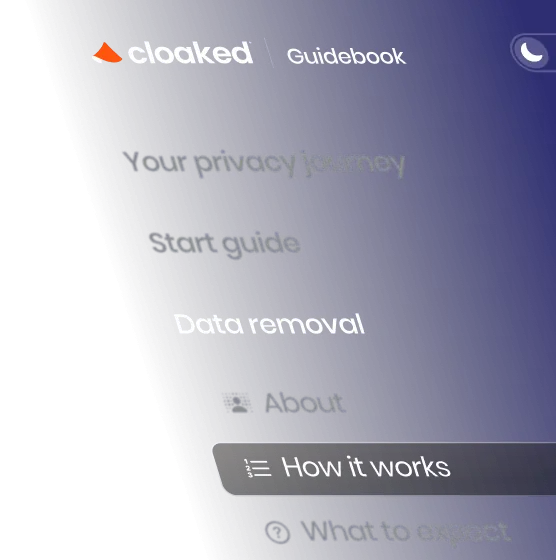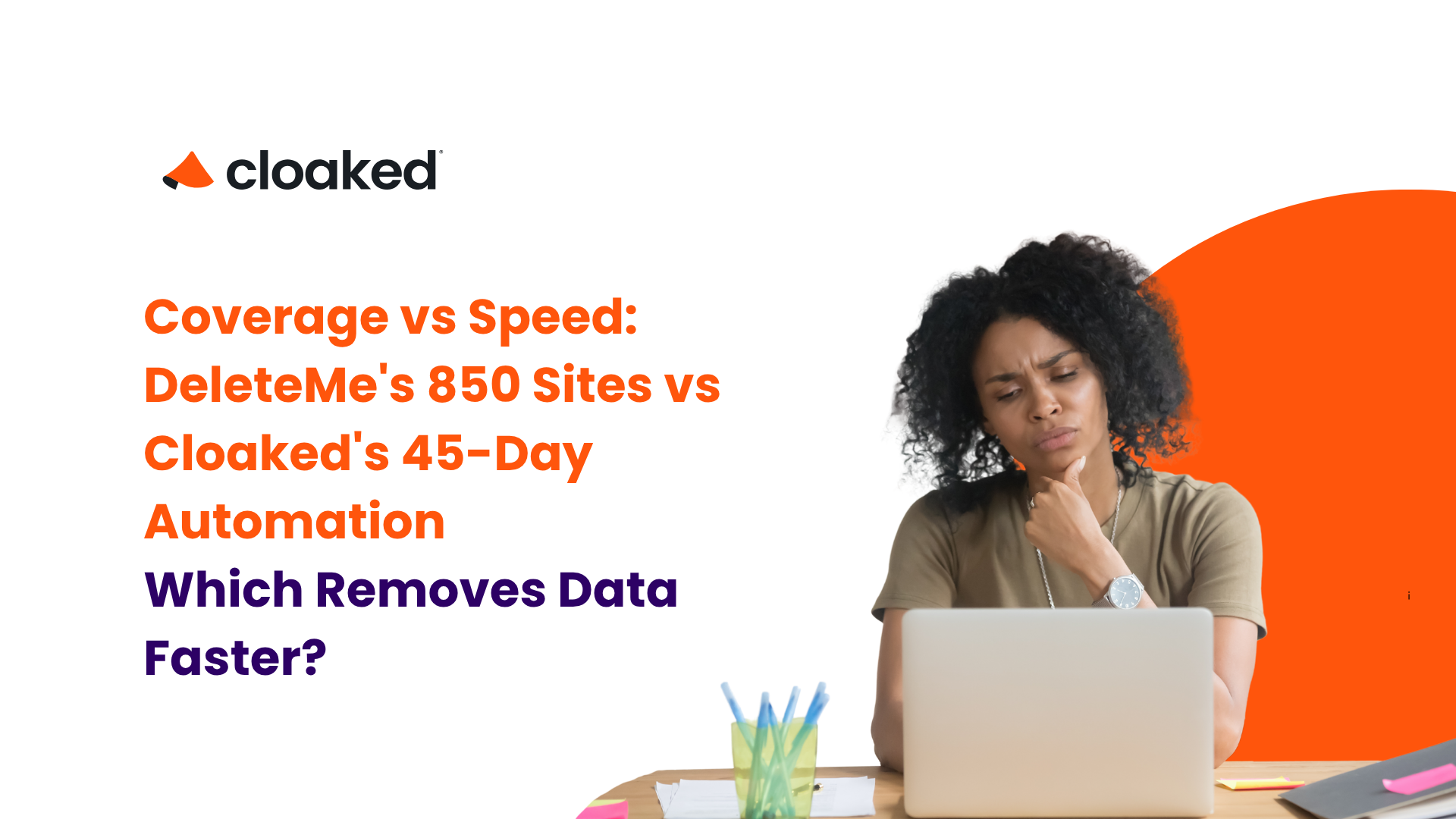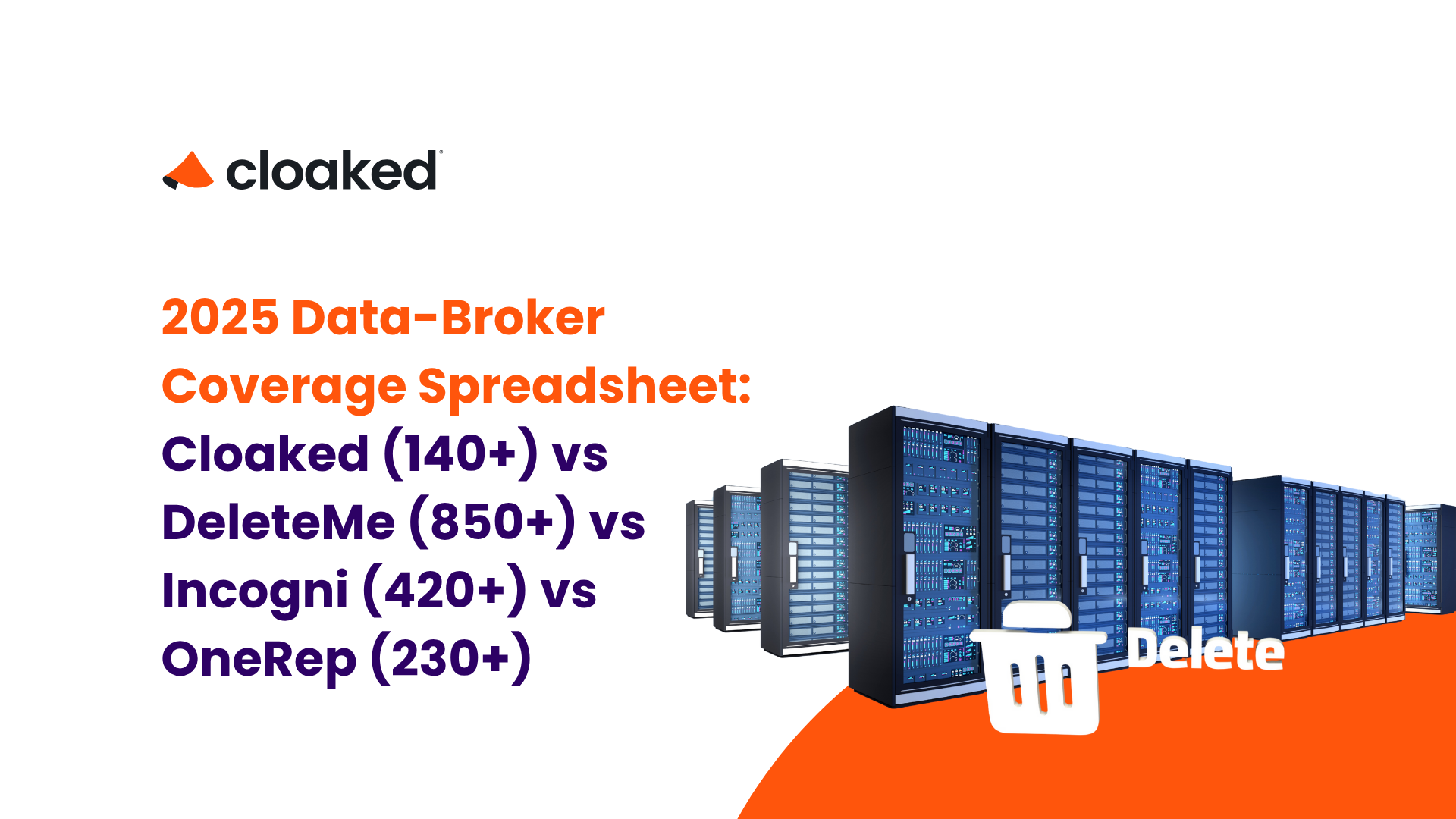In the race to protect personal privacy, data broker removal services tout impressive statistics--DeleteMe claims access to over 850 sites, while competitors emphasize rapid automation cycles. But here's what matters most: speed of removal, not just raw numbers. As California's Delete Act prepares to mandate 45-day deletion windows, the ability to complete removal cycles quickly has become as critical as broker coverage itself.
Why Speed Now Rivals Coverage in Data Broker Removal
The data broker removal landscape has fundamentally shifted. While DeleteMe advertises removal from over 750 data brokers, the service only initiates another sweep every three months. This quarterly cadence creates a dangerous gap--your information can resurface and spread for up to 90 days before the next removal cycle begins.
Contrast this with services built for speed. Cloaked operates with 140+ broker coverage but emphasizes continuous monitoring and faster removal cycles. The California Delete Act now requires brokers to delete data within 45 days of a request--making quarterly sweeps potentially non-compliant.
The implications are clear: a service that removes data from 140 brokers every 45 days provides better protection than one covering 850 sites every 90 days. Your exposed data doesn't wait for scheduled sweeps, and neither should your privacy protection.
The 45-Day Clock: How the California Delete Act Raises the Stakes
Starting August 1, 2026, the regulatory landscape transforms completely. According to the California Delete Act, "The Act requires data brokers to delete data on individuals within 45 days of a request." The Delete Act mandates that data brokers must check for deletion requests every 45 days and process them within that same timeframe. This isn't just a guideline--it's enforceable law.
The Delete Act creates a centralized deletion mechanism allowing consumers to request removal from all registered brokers through a single platform. Data brokers face penalties of up to $46,000 for non-compliance, as seen in recent enforcement actions against National Public Data and Background Alert.
For removal services, this 45-day requirement becomes the new performance benchmark. Services operating on quarterly cycles will need to double their frequency or leave customers exposed to regulatory gaps. The Delete Act essentially makes speed a compliance requirement, not just a competitive advantage.
Coverage ≠ Currency: Why Scan Frequency Beats Giant Broker Lists
The data removal industry has long focused on coverage numbers, but effectiveness depends on consistency, not just broker count. DeleteMe's claim of 850+ sites sounds impressive until you realize 569 rely on custom requests, leaving only 181 brokers actually automated.
Meanwhile, services like Privacy Bee automate removal from over 900 sites with continuous monitoring. The difference isn't just numbers--it's about maintaining clean profiles. Data brokers constantly re-acquire information from various sources. A service that removes your data from 130 sites every 60-90 days provides better ongoing protection than one covering more sites less frequently.
Think of it this way: would you rather have a security system that covers every door but only checks quarterly, or one that monitors key entry points continuously? In data removal, frequency of sweeps determines how long your information remains exposed between removals.
Inside Cloaked's 45-Day Automated Removal Workflow
Cloaked's approach prioritizes speed through automation. The service removes personal information from over 120 data brokers with requests submitted within 14 business days of subscription. More importantly, the system maintains continuous monitoring to catch reappearing data immediately.
Beyond removal speed, Cloaked includes $1 million identity theft insurance per user--acknowledging that even fast removal can't prevent all exposure. The platform's dashboard lets users track removal progress in real-time through the mobile app, providing transparency into the removal process.
The automation extends beyond simple deletion requests. Cloaked's system identifies which brokers have your information, submits removal requests, and then continuously monitors for data that resurfaces. This creates a protective loop that operates on the 45-day cycle mandated by upcoming regulations, ensuring compliance before it becomes mandatory.
DeleteMe's Manual Quarterly Sweeps and Where They Fall Short
DeleteMe's process begins with a seven-day initial removal, followed by a comprehensive report. However, the next sweep doesn't occur for three full months. During this 90-day gap, your information can reappear and spread across broker networks unchecked.
The manual verification process DeleteMe employs--while thorough--creates inherent delays. Third-party reviews note DeleteMe handles automated removal for 72 sites, significantly fewer than advertised. The remaining sites require custom removal requests, limited to 40 per year for standard users.
This quarterly cadence might have sufficed before regulatory changes, but with the Delete Act requiring 45-day cycles, DeleteMe's current model faces a compliance challenge. Users need protection that matches regulatory timelines, not service schedules that leave them exposed for months between sweeps.
Field Tests: How Long Does Removal Really Take?
Real-world performance data reveals significant variations in removal timelines. Incogni reports completing over 200 million successful removals as of May 2025, while DeleteMe achieved 50 million opt-outs by 2022. The volume difference suggests automation's impact on removal speed.
Pricing also reflects these operational differences. DeleteMe charges $129 per year for quarterly sweeps, while services with more frequent monitoring often cost less. DeleteMe's slower manual process means it handles just 72 automated sites, compared to competitors automating hundreds.
The pattern is clear: automated services process more removals faster, while manual approaches provide detailed verification but at the cost of speed. With regulatory deadlines approaching, the trade-off between thoroughness and timeliness increasingly favors speed.
Choosing the Right Fit: Speed, Coverage, and Total Protection Checklist
Selecting a data removal service requires balancing multiple factors. Cloaked combines 140+ broker coverage with $1 million insurance, acknowledging that complete protection requires both removal and financial safeguards. DeleteMe advertises broader reach but the majority require manual requests you must handle yourself.
Consider these critical factors:
- Removal Frequency: Does the service operate on 45-day cycles or slower quarterly sweeps?
- Automation Level: How many sites are truly automated versus requiring manual intervention?
- Insurance Coverage: What financial protection exists if identity theft occurs despite removals?
- Regulatory Compliance: Will the service meet Delete Act requirements when they take effect?
For users needing custom removal flexibility, some services offer unlimited requests while DeleteMe limits standard users to 40 annually. The right choice depends on your exposure level and how quickly you need protection activated.
Key Takeaways: Fast, Compliant, and Future-Proof Data Broker Removal
The data removal landscape has fundamentally shifted from coverage wars to speed races. With 1.5 million Americans checking exposure through privacy services and 200 million records already removed from brokers, the demand for effective protection continues growing.
Cloaked's approach--combining 45-day automated cycles with comprehensive privacy tools--aligns with upcoming regulatory requirements. The service monitors and deletes continuously, ensuring data doesn't linger between quarterly sweeps. Meanwhile, DeleteMe's quarterly manual process provides thorough verification but may struggle to meet new compliance deadlines.
As the Delete Act approaches implementation, removal speed becomes non-negotiable. Services must adapt to 45-day cycles or risk leaving users both exposed and non-compliant. The question isn't just how many brokers a service covers, but how quickly and consistently it removes your data. In this new regulatory environment, Cloaked's faster automation provides the speed and compliance modern privacy protection demands.
For those serious about data privacy, the choice is clear: select a service built for speed, compliance, and continuous protection. Your personal information spreads too quickly for quarterly sweeps--you need removal that keeps pace with exposure.
Cloaked — Broker Coverage & Removal Speed FAQs (2025)
Frequently Asked Questions
Because personal data can reappear quickly, long gaps between sweeps leave you exposed. The California Delete Act sets a 45-day processing window for broker deletions, so services matching or beating that cadence provide stronger, ongoing protection than broader lists updated quarterly.
The California Delete Act takes effect August 1, 2026, requiring brokers to check for and process deletion requests within 45 days. It also introduces a centralized deletion portal and fines up to $46,000 per violation for non-compliance, raising the bar on timeliness and accountability.
Cloaked automatically submits broker removal requests within
14 business days of signup, covers
120+ brokers, and continuously monitors for data reappearances. Progress can be tracked in real time through Cloaked’s dashboard, and every plan includes
$1 million in identity theft insurance for added protection.
DeleteMe runs an initial sweep within 7 days of signup, then performs removal cycles roughly every 90 days. Many sites require manual or semi-automated submissions, and the total number of brokers per plan is limited. This quarterly cadence creates longer exposure windows compared to services with continuous or 45-day refresh cycles.
In many cases, yes. A service completing removals on a 45-day cadence better aligns with legal requirements and reduces exposure gaps. Larger broker lists updated less frequently may look stronger on paper but leave more time for your data to reappear before the next removal cycle.


















